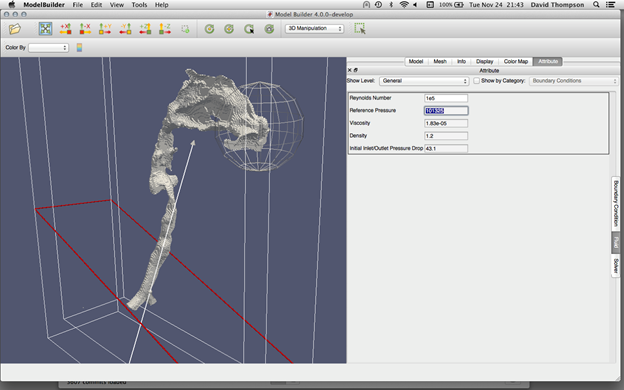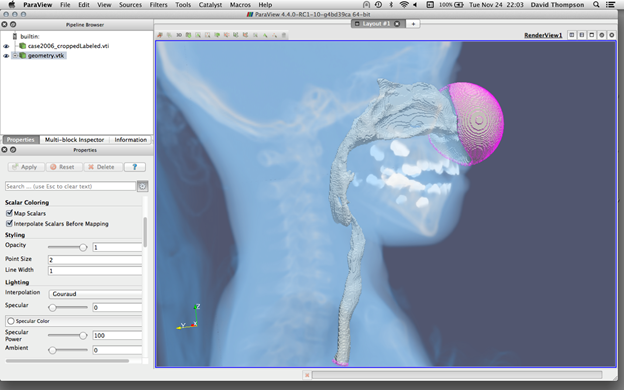A research team at Kitware, led by Cory Quammen, and collaborators at the University of North Carolina at Chapel Hill (UNC-Chapel Hill) have developed a highly specialized prototype software tool for surgical modeling and evaluation, called Virtual Pediatric Airways Workbench (VPAW). VPAW aims to reduce subjectivity in the surgical decision-making process by providing objective measures founded on physics-based standards derived from fluid flow simulations.
As shown below, the surgical planning workflow of VPAW has four main components: segmentation, interactive surgical modeling, visualization, and airflow simulation. For these components, VPAW makes use of several resources. VPAW implements the Visualization Toolkit (VTK) for interactive surgical modeling and visualization. For image segmentation, VPAW utilizes the Insight Segmentation and Registration Toolkit (ITK). VPAW also employs ITK for image editing. In addition, VPAW uses the Virtual Reality Peripheral Network (VRPN) for interfacing with three-dimensional input devices required for intuitive geometric model editing.
One of the important aspects of VPAW is the simulation module, which simulates airflow through patient-specific airway geometry. The module applies a lattice Boltzmann method (LBM) implementation from Dr. Sorin Mitran at UNC-Chapel Hill. This LBM simulates fluid flow using fictitious particles that propagate over a discrete lattice mesh overlaid on the problem domain. The Boltzmann equation governs the particles’ movement, as does the nature of the interactions (collisions), which depends on the nature of the fluid being simulated. The LBM can simulate complex fluid phenomenon and naturally lends itself to parallelization.
The inputs to the airflow simulation engine in VPAW include (a) an indexed regular lattice grid, (b) the flow boundary conditions, (c) the physical properties of the fluid, and (d) the simulation parameters for the LBM. A custom CMB plug-in provides this input deck to the fluid simulation engine, given only a CT scan and a segmentation of the airway within the scan created using an ITK-based tool.
CMB interactively sets the boundary conditions, the fluid properties, and the simulation parameters as shown below.
In the case of pediatric airways, CMB approximates ambient conditions based on the placement of a sphere around the inlet of the nostrils and on the ambient conditions settings at the boundary of the sphere. CMB enables moving and placing the sphere in relation to the entry point of the airway. CMB also enables choosing the airway exit point based on the intersection of airway voxels with a manually placed plane.
The below image shows the label map contours used by the simulation volume rendered in the context with the original CT data. After establishing the required inputs, CMB offers the option to export simulation settings into a file that CMB inputs to the simulation engine fluid solver.
For additional information, please read “Employing Computational Model Builder for Surgical Planning and Simulation Applications in Medicine” in the Kitware Source.




Recent Comments